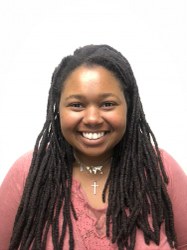Biography:
Brittany T. Williams is a Ph.D. candidate in Communication Sciences & Disorders at the College of Health and Human Development of PSU. In addition to her research responsibilities, she is a teaching assistant for Acoustic Principles in Communication Disorders. Brittany received a B.A. in Psychology and Foreign Languages and Literature at the University of South Alabama, as well as a M.A. in Psychology from the State University of New York at New Paltz. Throughout Brittany’s undergraduate and graduate journey, her research interests have centered on understanding how people are efficient and resilient in perceiving speech despite variability in the acoustic signal. In Summer 2020, she will work with Dr. Susanne Brouwer at Radboud in Nijmegen.
Project Summary:
Although all listeners may experience challenges understanding a person (i.e., target) in the presence of competing talkers (i.e., masker), this task is even more challenging for non-native listeners. One research paradigm is Linguistic Release from Masking (LRM), in which masking of a target language (e.g., English) decreases with increasingly dissimilar language backgrounds (e.g., Dutch). Some LRM experiments show that listeners can ignore their non-native language but not their native language. In addition, visual speech information from a person’s face during natural conversation improves speech-on-speech perception.
Our study combines LRM and visual speech information to examine how LRM changes when listeners are exposed to audiovisual relative to audio-only non-native speech. If bilinguals benefit more from audiovisual integration, even in the presence of competing speech, this could influence the implementation of visual speech information in research studies investigating bilingual speech processing.
A greater reliance on visual information could further understanding of how bilingual listeners perceive articulatory changes. Therefore, our findings may have clinical and educational implications, and may support the importance of utilizing audiovisual materials in second-language instruction when teaching non-native speakers how to produce certain sounds, not to mention processing speech in any non-native languages. More broadly, considering that multilingual speakers comprise at least half of the global population and will increase in the future, it is important to work toward a comprehensive understanding of speech processing in bilinguals.
